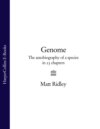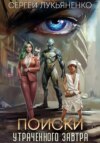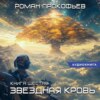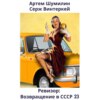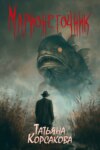Читать книгу: «Genome: The Autobiography of a Species in 23 Chapters», страница 2
In the beginning was the word. The word was not DNA. That came afterwards, when life was already established, and when it had divided the labour between two separate activities: chemical work and information storage, metabolism and replication. But DNA contains a record of the word, faithfully transmitted through all subsequent aeons to the astonishing present.
Imagine the nucleus of a human egg beneath the microscope. Arrange the twenty-three chromosomes, if you can, in order of size, the biggest on the left and the smallest on the right. Now zoom in on the largest chromosome, the one called, for purely arbitrary reasons, chromosome 1. Every chromosome has a long arm and a short arm separated by a pinch point known as a centromere. On the long arm of chromosome 1, close to the centromere, you will find, if you read it carefully, that there is a sequence of 120 letters – As, Cs, Gs and Ts – that repeats over and over again. Between each repeat there lies a stretch of more random text, but the 120-letter paragraph keeps coming back like a familiar theme tune, in all more than 100 times. This short paragraph is perhaps as close as we can get to an echo of the original word.
This ‘paragraph’ is a small gene, probably the single most active gene in the human body. Its 120 letters are constantly being copied into a short filament of RNA. The copy is known as 5S RNA. It sets up residence with a lump of proteins and other RNAs, carefully intertwined, in a ribosome, a machine whose job is to translate DNA recipes into proteins. And it is proteins that enable DNA to replicate. To paraphrase Samuel Butler, a protein is just a gene’s way of making another gene; and a gene is just a protein’s way of making another protein. Cooks need recipes, but recipes also need cooks. Life consists of the interplay of two kinds of chemicals: proteins and DNA.
Protein represents chemistry, living, breathing, metabolism and behaviour – what biologists call the phenotype. DNA represents information, replication, breeding, sex – what biologists call the genotype. Neither can exist without the other. It is the classic case of chicken and egg: which came first, DNA or protein? It cannot have been DNA, because DNA is a helpless, passive piece of mathematics, which catalyses no chemical reactions. It cannot have been protein, because protein is pure chemistry with no known way of copying itself accurately. It seems impossible either that DNA invented protein or vice versa. This might have remained a baffling and strange conundrum had not the word left a trace of itself faintly drawn on the filament of life. Just as we now know that eggs came long before chickens (the reptilian ancestors of all birds laid eggs), so there is growing evidence that RNA came before proteins.
RNA is a chemical substance that links the two worlds of DNA and protein. It is used mainly in the translation of the message from the alphabet of DNA to the alphabet of proteins. But in the way it behaves, it leaves little doubt that it is the ancestor of both. RNA was Greece to DNA’s Rome: Homer to her Virgil.
RNA was the word. RNA left behind five little clues to its priority over both protein and DNA. Even today, the ingredients of DNA are made by modifying the ingredients of RNA, not by a more direct route. Also DNA’s letter Ts are made from RNA’s letter Us. Many modern enzymes, though made of protein, rely on small molecules of RNA to make them work. Moreover, RNA, unlike DNA and protein, can copy itself without assistance: give it the right ingredients and it will stitch them together into a message. Wherever you look in the cell, the most primitive and basic functions require the presence of RNA. It is an RNA-dependent enzyme that takes the message, made of RNA, from the gene. It is an RNA-containing machine, the ribosome, that translates that message, and it is a little RNA molecule that fetches and carries the amino acids for the translation of the gene’s message. But above all, RNA – unlike DNA – can act as a catalyst, breaking up and joining other molecules including RNAs themselves. It can cut them up, join the ends together, make some of its own building blocks, and elongate a chain of RNA. It can even operate on itself, cutting out a chunk of text and splicing the free ends together again.7
The discovery of these remarkable properties of RNA in the early 1980s, made by Thomas Cech and Sidney Altman, transformed our understanding of the origin of life. It now seems probable that the very first gene, the ‘ur-gene’, was a combined replicator–catalyst, a word that consumed the chemicals around it to duplicate itself. It may well have been made of RNA. By repeatedly selecting random RNA molecules in the test tube based on their ability to catalyse reactions, it is possible to ‘evolve’ catalytic RNAs from scratch – almost to rerun the origin of life. And one of the most surprising results is that these synthetic RNAs often end up with a stretch of RNA text that reads remarkably like part of the text of a ribosomal RNA gene such as the 5S gene on chromosome 1.
Back before the first dinosaurs, before the first fishes, before the first worms, before the first plants, before the first fungi, before the first bacteria, there was an RNA world – probably somewhere around four billion years ago, soon after the beginning of planet earth’s very existence and when the universe itself was only ten billion years old. We do not know what these ‘ribo-organisms’ looked like. We can only guess at what they did for a living, chemically speaking. We do not know what came before them. We can be pretty sure that they once existed, because of the clues to RNA’s role that survive in living organisms today.8
These ribo-organisms had a big problem. RNA is an unstable substance, which falls apart within hours. Had these organisms ventured anywhere hot, or tried to grow too large, they would have faced what geneticists call an error catastrophe – a rapid decay of the message in their genes. One of them invented by trial and error a new and tougher version of RNA called DNA and a system for making RNA copies from it, including a machine we’ll call the proto-ribosome. It had to work fast and it had to be accurate. So it stitched together genetic copies three letters at a time, the better to be fast and accurate. Each threesome came flagged with a tag to make it easier for the proto-ribosome to find, a tag that was made of amino acid. Much later, those tags themselves became joined together to make proteins and the three-letter word became a form of code for the proteins – the genetic code itself. (Hence to this day, the genetic code consists of three-letter words, each spelling out a particular one of twenty amino acids as part of a recipe for a protein.) And so was born a more sophisticated creature that stored its genetic recipe on DNA, made its working machines of protein and used RNA to bridge the gap between them.
Her name was Luca, the Last Universal Common Ancestor. What did she look like, and where did she live? The conventional answer is that she looked like a bacterium and she lived in a warm pond, possibly by a hot spring, or in a marine lagoon. In the last few years it has been fashionable to give her a more sinister address, since it became clear that the rocks beneath the land and sea are impregnated with billions of chemical-fuelled bacteria. Luca is now usually placed deep underground, in a fissure in hot igneous rocks, where she fed on sulphur, iron, hydrogen and carbon. To this day, the surface life on earth is but a veneer. Perhaps ten times as much organic carbon as exists in the whole biosphere is in thermophilic bacteria deep beneath the surface, where they are possibly responsible for generating what we call natural gas.9
There is, however, a conceptual difficulty about trying to identify the earliest forms of life. These days it is impossible for most creatures to acquire genes except from their parents, but that may not always have been so. Even today, bacteria can acquire genes from other bacteria merely by ingesting them. There might once have been widespread trade, even burglary, of genes. In the deep past chromosomes were probably numerous and short, containing just one gene each, which could be lost or gained quite easily. If this was so, Carl Woese points out, the organism was not yet an enduring entity. It was a temporary team of genes. The genes that ended up in all of us may therefore have come from lots of different ‘species’ of creature and it is futile to try to sort them into different lineages. We are descended not from one ancestral Luca, but from the whole community of genetic organisms. Life, says Woese, has a physical history, but not a genealogical one.10
You can look on such a conclusion as a fuzzy piece of comforting, holistic, communitarian philosophy – we are all descended from society, not from an individual species – or you can see it as the ultimate proof of the theory of the selfish gene: in those days, even more than today, the war was carried on between genes, using organisms as temporary chariots and forming only transient alliances; today it is more of a team game. Take your pick.
Even if there were lots of Lucas, we can still speculate about where they lived and what they did for a living. This is where the second problem with the thermophilic bacteria arises. Thanks to some brilliant detective work by three New Zealanders published in 1998, we can suddenly glimpse the possibility that the tree of life, as it appears in virtually every textbook, may be upside down. Those books assert that the first creatures were like bacteria, simple cells with single copies of circular chromosomes, and that all other living things came about when teams of bacteria ganged together to make complex cells. It may much more plausibly be the exact reverse. The very first modern organisms were not like bacteria; they did not live in hot springs or deep-sea volcanic vents. They were much more like protozoa: with genomes fragmented into several linear chromosomes rather than one circular one, and ‘polyploid’ – that is, with several spare copies of every gene to help with the correction of spelling errors. Moreover, they would have liked cool climates. As Patrick Forterre has long argued, it now looks as if bacteria came later, highly specialised and simplified descendants of the Lucas, long after the invention of the DNA-protein world. Their trick was to drop much of the equipment of the RNA world specifically to enable them to live in hot places. It is we that have retained the primitive molecular features of the Lucas in our cells; bacteria are much more ‘highly evolved’ than we are.
This strange tale is supported by the existence of molecular ‘fossils’ – little bits of RNA that hang about inside the nucleus of your cells doing unnecessary things such as splicing themselves out of genes: guide RNA, vault RNA, small nuclear RNA, small nucleolar RNA, self-splicing introns. Bacteria have none of these, and it is more parsimonious to believe that they dropped them rather than we invented them. (Science, perhaps surprisingly, is supposed to treat simple explanations as more probable than complex ones unless given reason to think otherwise; the principle is known in logic as Occam’s razor.) Bacteria dropped the old RNAs when they invaded hot places like hot springs or subterranean rocks where temperatures can reach 170 °C – to minimise mistakes caused by heat, it paid to simplify the machinery. Having dropped the RNAs, bacteria found their new streamlined cellular machinery made them good at competing in niches where speed of reproduction was an advantage – such as parasitic and scavenging niches. We retained those old RNAs, relics of machines long superseded, but never entirely thrown away. Unlike the massively competitive world of bacteria, we – that is all animals, plants and fungi – never came under such fierce competition to be quick and simple. We put a premium instead on being complicated, in having as many genes as possible, rather than a streamlined machine for using them.11
The three-letter words of the genetic code are the same in every creature. CGA means arginine and GCG means alanine – in bats, in beetles, in beech trees, in bacteria. They even mean the same in the misleadingly named archaebacteria living at boiling temperatures in sulphurous springs thousands of feet beneath the surface of the Atlantic ocean or in those microscopic capsules of deviousness called viruses. Wherever you go in the world, whatever animal, plant, bug or blob you look at, if it is alive, it will use the same dictionary and know the same code. All life is one. The genetic code, bar a few tiny local aberrations, mostly for unexplained reasons in the ciliate protozoa, is the same in every creature. We all use exactly the same language.
This means – and religious people might find this a useful argument – that there was only one creation, one single event when life was born. Of course, that life might have been born on a different planet and seeded here by spacecraft, or there might even have been thousands of kinds of life at first, but only Luca survived in the ruthless free-for-all of the primeval soup. But until the genetic code was cracked in the 1960s, we did not know what we now know: that all life is one; seaweed is your distant cousin and anthrax one of your advanced relatives. The unity of life is an empirical fact. Erasmus Darwin was outrageously close to the mark: ‘One and the same kind of living filaments has been the cause of all organic life.’
In this way simple truths can be read from the book that is the genome: the unity of all life, the primacy of RNA, the chemistry of the very earliest life on the planet, the fact that large, single-celled creatures were probably the ancestors of bacteria, not vice versa. We have no fossil record of the way life was four billion years ago. We have only this great book of life, the genome. The genes in the cells of your little finger are the direct descendants of the first replicator molecules; through an unbroken chain of tens of billions of copyings, they come to us today still bearing a digital message that has traces of those earliest struggles of life. If the human genome can tell us things about what happened in the primeval soup, how much more can it tell us about what else happened during the succeeding four million millennia. It is a record of our history written in the code for a working machine.
CHROMOSOME 2 Species
Man with all his noble qualities still bears in his bodily frame the indelible stamp of his lowly origin.
Charles Darwin
Sometimes the obvious can stare you in the face. Until 1955, it was agreed that human beings had twenty-four pairs of chromosomes. It was just one of those facts that everybody knew was right. They knew it was right because in 1921 a Texan named Theophilus Painter had sliced thin sections off the testicles of two black men and one white man castrated for insanity and ‘self-abuse’, fixed the slices in chemicals and examined them under the microscope. Painter tried to count the tangled mass of unpaired chromosomes he could see in the spermatocytes of the unfortunate men, and arrived at the figure of twenty-four. ‘I feel confident that this is correct,’ he said. Others later repeated his experiment in other ways. All agreed the number was twenty-four.
For thirty years, nobody disputed this ‘fact’. One group of scientists abandoned their experiments on human liver cells because they could only find twenty-three pairs of chromosomes in each cell. Another researcher invented a method of separating the chromosomes, but still he thought he saw twenty-four pairs. It was not until 1955, when an Indonesian named Joe-Hin Tjio travelled from Spain to Sweden to work with Albert Levan, that the truth dawned. Tjio and Levan, using better techniques, plainly saw twenty-three pairs. They even went back and counted twenty-three pairs in photographs in books where the caption stated that there were twenty-four pairs. There are none so blind as do not wish to see.1
It is actually rather surprising that human beings do not have twenty-four pairs of chromosomes. Chimpanzees have twenty-four pairs of chromosomes; so do gorillas and orang utans. Among the apes we are the exception. Under the microscope, the most striking and obvious difference between ourselves and all the other great apes is that we have one pair less. The reason, it immediately becomes apparent, is not that a pair of ape chromosomes has gone missing in us, but that two ape chromosomes have fused together in us. Chromosome 2, the second biggest of the human chromosomes, is in fact formed from the fusion of two medium-sized ape chromosomes, as can be seen from the pattern of black bands on the respective chromosomes.
Pope John-Paul II, in his message to the Pontifical Academy of Sciences on 22 October 1996, argued that between ancestral apes and modern human beings, there was an ‘ontological discontinuity’ – a point at which God injected a human soul into an animal lineage. Thus can the Church be reconciled to evolutionary theory. Perhaps the ontological leap came at the moment when two ape chromosomes were fused, and the genes for the soul lie near the middle of chromosome 2.
The pope notwithstanding, the human species is by no means the pinnacle of evolution. Evolution has no pinnacle and there is no such thing as evolutionary progress. Natural selection is simply the process by which life-forms change to suit the myriad opportunities afforded by the physical environment and by other life-forms. The black-smoker bacterium, living in a sulphurous vent on the floor of the Atlantic ocean and descended from a stock of bacteria that parted company with our ancestors soon after Luca’s day, is arguably more highly evolved than a bank clerk, at least at the genetic level. Given that it has a shorter generation time, it has had more time to perfect its genes.
This book’s obsession with the condition of one species, the human species, says nothing about that species’ importance. Human beings are of course unique. They have, perched between their ears, the most complicated biological machine on the planet. But complexity is not everything, and it is not the goal of evolution. Every species on the planet is unique. Uniqueness is a commodity in oversupply. None the less, I propose to try to probe this human uniqueness in this chapter, to uncover the causes of our idiosyncrasy as a species. Forgive my parochial concerns. The story of a briefly abundant hairless primate originating in Africa is but a footnote in the history of life, but in the history of the hairless primate it is central. What exactly is the unique selling point of our species?
Human beings are an ecological success. They are probably the most abundant large animal on the whole planet. There are nearly six billion of them, amounting collectively to something like 300 million tons of biomass. The only large animals that rival or exceed this quantity are ones we have domesticated – cows, chickens and sheep – or that depend on man-made habitats: sparrows and rats. By contrast, there are fewer than a thousand mountain gorillas in the world and even before we started slaughtering them and eroding their habitat there may not have been more than ten times that number. Moreover, the human species has shown a remarkable capacity for colonising different habitats, cold or hot, dry or wet, high or low, marine or desert. Ospreys, barn owls and roseate terns are the only other large species to thrive in every continent except Antarctica and they remain strictly confined to certain habitats. No doubt, this ecological success of the human being comes at a high price and we are doomed to catastrophe soon enough: for a successful species we are remarkably pessimistic about the future. But for now we are a success.
Yet the remarkable truth is that we come from a long line of failures. We are apes, a group that almost went extinct fifteen million years ago in competition with the better-designed monkeys. We are primates, a group of mammals that almost went extinct forty-five million years ago in competition with the better-designed rodents. We are synapsid tetrapods, a group of reptiles that almost went extinct 200 million years ago in competition with the better-designed dinosaurs. We are descended from limbed fishes, which almost went extinct 360 million years ago in competition with the better-designed ray-finned fishes. We are chordates, a phylum that survived the Cambrian era 500 million years ago by the skin of its teeth in competition with the brilliantly successful arthropods. Our ecological success came against humbling odds.
In the four billion years since Luca, the word grew adept at building what Richard Dawkins has called ‘survival machines’: large, fleshy entities known as bodies that were good at locally reversing entropy the better to replicate the genes within them. They had done this by a venerable and massive process of trial and error, known as natural selection. Trillions of new bodies had been built, tested and enabled to breed only if they met increasingly stringent criteria for survival. At first, this had been a simple business of chemical efficiency: the best bodies were cells that found ways to convert other chemicals into DNA and protein. This phase lasted for about three billion years and it seemed as if life on earth, whatever it might do on other planets, consisted of a battle between competing strains of amoebae. Three billion years during which trillions of trillions of single-celled creatures lived, each one reproducing and dying every few days or so, amounts to a big heap of trial and error.
But it turned out that life was not finished. About a billion years ago, there came, quite suddenly, a new world order, with the invention of bigger, multicellular bodies, a sudden explosion of large creatures. Within the blink of a geological eye (the so-called Cambrian explosion may have lasted a mere ten or twenty million years), there were vast creatures of immense complexity: scuttling trilobites nearly a foot long; slimy worms even longer; waving algae half a yard across. Single-celled creatures still dominated, but these great unwieldy forms of giant survival machines were carving out a niche for themselves. And, strangely, these multicellular bodies had hit upon a sort of accidental progress. Although there were occasional setbacks caused by meteorites crashing into the earth from space, which had an unfortunate tendency to extirpate the larger and more complex forms, there was a trend of sorts discernible. The longer animals existed, the more complex some of them became. In particular, the brains of the brainiest animals were bigger and bigger in each successive age: the biggest brains in the Paleozoic were smaller than the biggest in the Mesozoic, which were smaller than the biggest in the Cenozoic, which were smaller than the biggest present now. The genes had found a way to delegate their ambitions, by building bodies capable not just of survival, but of intelligent behaviour as well. Now, if a gene found itself in an animal threatened by winter storms, it could rely on its body to do something clever like migrate south or build itself a shelter.
Our breathless journey from four billion years ago brings us to just ten million years ago. Past the first insects, fishes, dinosaurs and birds to the time when the biggest-brained creature on the planet (corrected for body size) was probably our ancestor, an ape. At that point, ten million years before the present, there probably lived at least two species of ape in Africa, though there may have been more. One was the ancestor of the gorilla, the other the common ancestor of the chimpanzee and the human being. The gorilla’s ancestor had probably taken to the montane forests of a string of central African volcanoes, cutting itself off from the genes of other apes. Some time over the next five million years the other species gave rise to two different descendant species in the split that led to human beings and to chimpanzees.
The reason we know this is that the story is written in the genes. As recently as 1950 the great anatomist J. Z. Young could write that it was still not certain whether human beings descended from a common ancestor with apes, or from an entirely different group of primates separated from the ape lineage more than sixty million years ago. Others still thought the orang utan might prove our closest cousin.2 Yet we now know not only that chimpanzees separated from the human line after gorillas did, but that the chimp–human split occurred not much more than ten, possibly even less than five, million years ago. The rate at which genes randomly accumulate spelling changes gives a firm indication of relationships between species. The spelling differences between gorilla and chimp are greater than the spelling differences between chimp and human being – in every gene, protein sequence or random stretch of DNA that you care to look at. At its most prosaic this means that a hybrid of human and chimpanzee DNA separates into its constituent strands at a higher temperature than do hybrids of chimp and gorilla DNA, or of gorilla and human DNA.
Calibrating the molecular clock to give an actual date in years is much more difficult. Because apes are long-lived and breed at a comparatively advanced age, their molecular clocks tick rather slowly (the spelling mistakes are picked up mostly at the moment of replication, at the creation of an egg or sperm). But it is not clear exactly how much to correct the clock for this factor; nor do all genes agree. Some stretches of DNA seem to imply an ancient split between chimps and human beings; others, such as the mitochondria, suggest a more recent date. The generally accepted range is five to ten million years.3
Apart from the fusion of chromosome 2, visible differences between chimp and human chromosomes are few and tiny. In thirteen chromosomes no visible differences of any kind exist. If you select at random any ‘paragraph’ in the chimp genome and compare it with the comparable ‘paragraph’ in the human genome, you will find very few ‘letters’ are different: on average, less than two in every hundred. We are, to a ninety-eight per cent approximation, chimpanzees, and they are, with ninety-eight per cent confidence limits, human beings. If that does not dent your self-esteem, consider that chimpanzees are only ninety-seven per cent gorillas; and humans are also ninety-seven per cent gorillas. In other words we are more chimpanzee-like than gorillas are.
How can this be? The differences between me and a chimp are immense. It is hairier, it has a different shaped head, a different shaped body, different limbs, makes different noises. There is nothing about chimpanzees that looks ninety-eight per cent like me. Oh really? Compared with what? If you took two Plasticene models of a mouse and tried to turn one into a chimpanzee, the other into a human being, most of the changes you would make would be the same. If you took two Plasticene amoebae and turned one into a chimpanzee, the other into a human being, almost all the changes you would make would be the same. Both would need thirty-two teeth, five fingers, two eyes, four limbs and a liver. Both would need hair, dry skin, a spinal column and three little bones in the middle ear. From the perspective of an amoeba, or for that matter a fertilised egg, chimps and human beings are ninety-eight per cent the same. There is no bone in the chimpanzee body that I do not share. There is no known chemical in the chimpanzee brain that cannot be found in the human brain. There is no known part of the immune system, the digestive system, the vascular system, the lymph system or the nervous system that we have and chimpanzees do not, or vice versa.
There is not even a brain lobe in the chimpanzee brain that we do not share. In a last, desperate defence of his species against the theory of descent from the apes, the Victorian anatomist Sir Richard Owen once claimed that the hippocampus minor was a brain lobe unique to human brains, so it must be the seat of the soul and the proof of divine creation. He could not find the hippocampus minor in the freshly pickled brains of gorillas brought back from the Congo by the adventurer Paul du Chaillu. Thomas Henry Huxley furiously responded that the hippocampus minor was there in ape brains. ‘No, it wasn’t’, said Owen. ‘Was, too’, said Huxley. Briefly, in 1861, the ‘hippocampus question’ was all the rage in Victorian London and found itself satirised in Punch and Charles Kingsley’s novel The water babies. Huxley’s point – of which there are loud modern echoes – was more than just anatomy:4 ‘It is not I who seek to base Man’s dignity upon his great toe, or insinuate that we are lost if an Ape has a hippocampus minor. On the contrary, I have done my best to sweep away this vanity.’ Huxley, by the way, was right.
After all, it is less than 300,000 human generations since the common ancestor of both species lived in central Africa. If you held hands with your mother, and she held hands with hers, and she with hers, the line would stretch only from New York to Washington before you were holding hands with the ‘missing link’ – the common ancestor with chimpanzees. Five million years is a long time, but evolution works not in years but in generations. Bacteria can pack in that many generations in just twenty-five years.
What did the missing link look like? By scratching back through the fossil record of direct human ancestors, scientists are getting remarkably close to knowing. The closest they have come is probably a little ape-man skeleton called Ardipithecus from just over four million years ago. Although a few scientists have speculated that Ardipithecus predates the missing link, it seems unlikely: the creature had a pelvis designed chiefly for upright walking; to modify that back to the gorilla-like pelvis design in the chimpanzee’s lineage would have been drastically improbable. We need to find a fossil several million years older to be sure we are looking at a common ancestor of us and chimps. But we can guess, from Ardipithecus, what the missing link looked like: its brain was probably smaller than a modern chimp’s. Its body was at least as agile on two legs as a modern chimp’s. Its diet, too, was probably like a modern chimp’s: mostly fruit and vegetation. Males were considerably bigger than females. It is hard, from the perspective of human beings, not to think of the missing link as more chimp-like than human-like. Chimps might disagree, of course, but none the less it seems as if our lineage has seen grosser changes than theirs.
Бесплатный фрагмент закончился.

